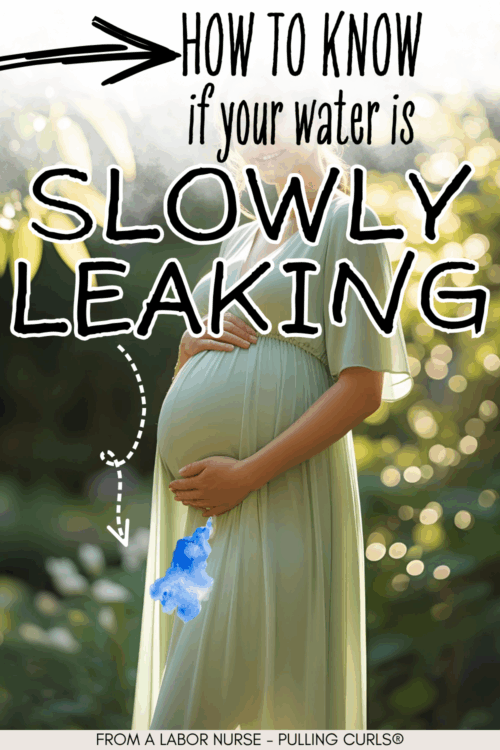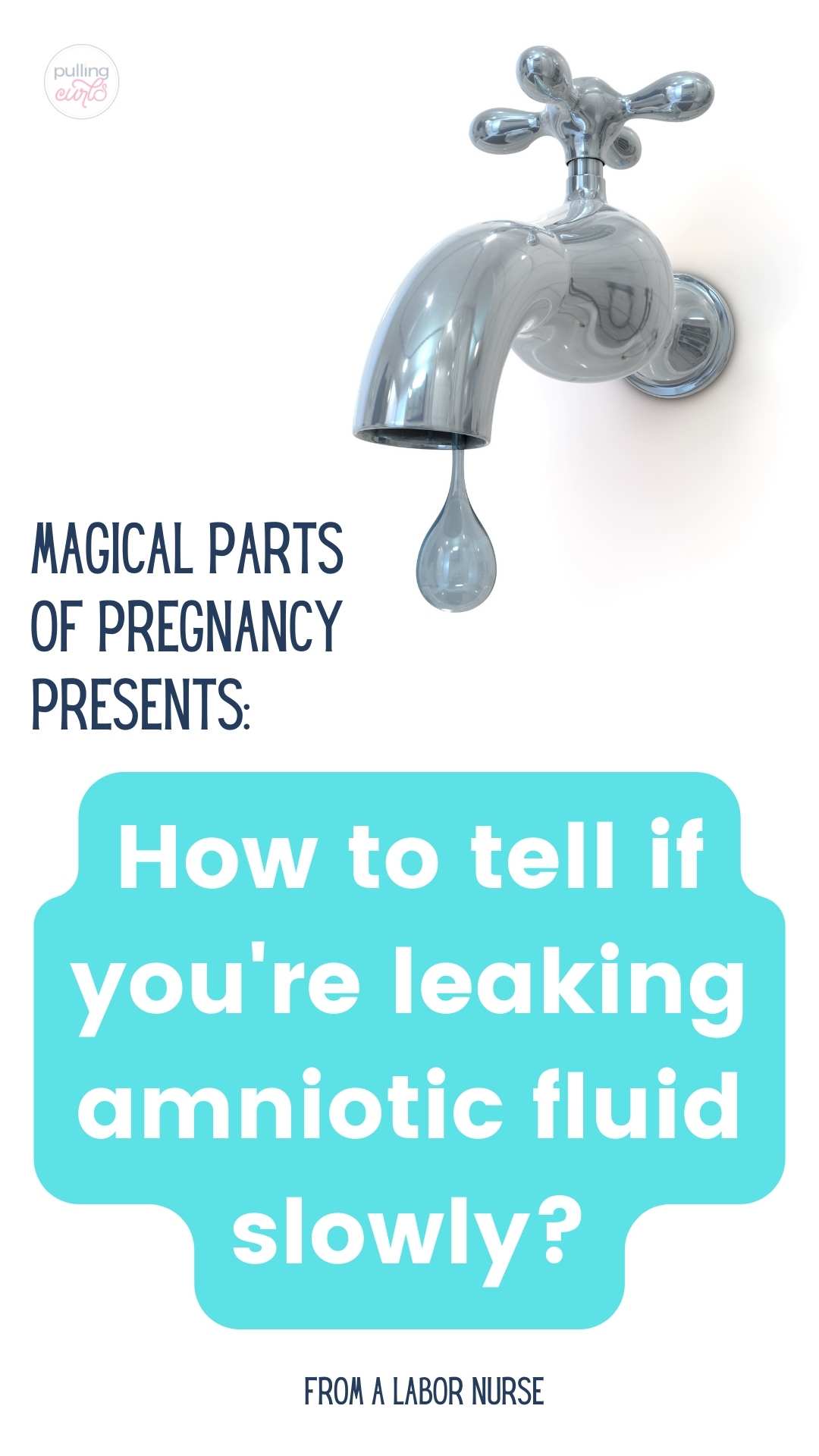You think that when your water breaks it will be SUPER easy to tell if your amniotic sac has broken or if it’s just vaginal discharge. BUT it is harder than you think to tell the the difference. So, today we’ll give you some ways to tell.

As always, please take the advice of your provider over anything on the internet, but most especially on this website. If you have ANY questions as to if you think your water broke, they are your best resource, please do use them.
How can you tell if your water is leaking slowly?
The best method is a test called Amnisure. It checks for the proteins that are only in amniotic fluid. To do it we just put a long Q-tip into your vagina and let it sit there for a minute, and then send it to the lab. It is a simple test that can be done at the hospital or sometimes at your doctor or midwife’s clinic. It is the definitive way to know. But, there are a few other ways to find out — and we’ll talk about those as well.
But first, how do I know so much about water breaking….
First off, hello! I’m Hilary — many people know me as The Pregnancy Nurse 👩⚕️. I have been a nurse since 1997 and I have 20 years of OB nursing experience, I am also the curly head behind this website Pulling Curls and The Online Prenatal Class for Couples. 🩺 I have checked thousands of women who think their water has broken, and have talked to them about their experiences at length — so I’m what you’d call a water breaking expert.
And if you’re just starting to realize that this whole labor thing can be a bit confusing, there is still time to get a birth class in. The Online Prenatal Class for Couples — in just a few hours we can get you prepared, you’ll feel SO much better about all of it!
❤️🧡💛💚💙💜 I love, Love, LOVE that you’re here preparing — but I gotta ask if your partner is just as on board for how different things are going to be. If you’re thinking you’d like for you to BOTH get prepared I recommend this. Check it out!
Anatomy Lesson: Your 3 Holes
I am not sure how our public school system lets people graduate without this knowledge, but ladies — we have three holes.
- A pee hole (urethra)
- A baby exit/have sex hole (vagina)
- A poop hole (rectum).
Which means you do not pee out of the same hole that the baby comes out of. Good news, right? I am hopeful a lot of you knew this already, but from my experience, a lot do not — so I wanted to be SURE you knew that!
And while we’re at it — have you packed your hospital bag:
A Leak vs a Gush of Amniotic Fluid
You probably picture that if your water has broken you’ll get a giant gush of fluid soaking your clothes, and all the surrounding bed/floor. And while this CAN happen, it doesn’t often work that way.
Often women will get just a slow trickle of amniotic fluid that comes out now and then as they move.
In general, that has to do with where in the uterus your membranes rupture. I have a whole post on how much fluid comes out that might be helpful for you.
Pro tip: Remember there is a bag of fluid that holds the baby, called the amniotic sac. It is that which ruptures when you water breaks, not actually your uterus.
Meaning, if it ruptures at the top of your uterus, you may only get a leak now and then, vs if it breaks at the bottom (near your cervix) it may all come gushing out.
And, sometimes baby’s head comes in and acts as a cork that stops the fluid from coming out, until you do movements that changes how their head is engaged.
And, if all of that seems super confusing, I explain it more in chapter 4 in here.
What to do if you think your water broke
While most people think you need to go to the hospital right away, that is not always necessary. Personally, I’d do these things in this order:
- Make sure that nothing has “come out” into your vagina besides the fluid– the two things we’re watching especially close for are
- The umbilical cord — while very rare this can happen. If you think the cord has fallen out you need to get your butt up above the baby (usually hands and knees with your head on the ground and your bum in the air) and call 911
- An arm/hand/leg — I’d probably do the same thing in this instance (bum in the air and call 911), although not as urgent it can be hard to tell which is the problem.
- Assess any other symptoms — are you having contractions, cramping, etc (it’s helpful to know the signs of labor when you’re doing this, because it’s not just contractions)
- Call my provider — even if you’ve had GUSH of fluid and are sure your water has broken, I’d call them just to get their take on what to do. Some may encourage you to come in, and some may tell you to hang out at home for a while until the contractions are stronger. Depends on you, your OB history and circumstances.
I know that some birth workers encourage you to just manage it at home once your water is broken, but I couldn’t disagree more. Your doctor can guide you through some important questions, and then you can make the choice for yourself (with the information they give you) when it’s best to go to the hopsital — and that answer may be different for everyone. For instance, your GBS status may change this answer for different people.
Have you checked a birth class off your to do list✅? I have a few I recommend:
❤️ Best class for couples {per BabyList}
👩💻 Best class available on demand
⚡ Best class JUST for pain management
👶 Best Postpartum-Only Prep
❤️🧡💛💚💙💜 My favorite class is here.
Now is the time to get started!
5 Ways To Tell If You Are Leaking Amniotic Fluid
Provider Testing
As I said above, you can have the fluid in your vagina checked to see if it’s amniotic fluid. Beyond just the Amnisure, there are a few other tests providers can do:
Nitrazine paper — this is what we used to use and can easily tell the difference between urine and amniotic fluid. They stopped using it because it is NOT definitive, but sometimes I miss it because of how easy it is to use.
Ferning — this is where they look at the fluid in your vagina. Under a microscope that fluid “ferns” (looks like fern leaves) — so they can tell if it is amniotic fluid. I think this is about as good as Amnisure, but not a lot of facilities have the equipment (slides, microscope, collection materials) readily available.
Amniotic Fluid Index — more commonly known as an AFI — this measures the amount of fluid in your uterus via ultrasound. The AFI is also part of a BPP (bio-physical profile) If you’re interested in all the 3rd trimester tests, I talk more about them in here.
Pooling — While certainly not definitive, sometimes they will look into your vaginal vault to see if any fluid is collecting in there. This is in no way is definitive, but can be a good indicator (especially if they need to do some other tests as well)
If your provider’s office can do the testing there, that’s your best bet since going to the hospital will require more time as you’ll have to be admitted and monitored once you’re there.
Some of the testing for amniotic fluid can’t be done if you’ve recently had sex or are bleeding a lot, so be sure to mention those things to your providers if they are reading to test you. Of course, if you are bleeding a lot you need to be seen either way {hopefull that goes without saying}
If you’re wondering what other types of testing we do in your later pregnancy check out my free prenatal class where we go over 3rd trimester testing and what it means!
Put a Pad On & Move
Put a sanitary pad on and go about your business — see if the fluid continues to come out, or if the pad is dry. Most often if your water is rupture the fluid will continue to come out and it can be a good indicator that perhaps your water is broken. If, after doing some housework for 15-20 minutes, the pad is bone dry, it’s a good chance that was some other type of fluid.
And yes, cleaning is one of my favorite things to do in early labor or this type of situation. It not only moves your body in ways that help, but also gets some household chores done. A double win in my book! I have a plan of things to do in early labor in here.
If you’re worried about fluids and your couch, or car, or workplace — check out these. I think those are crazy helpful for after kids too!
Laugh, Cough or Bear Down
Often more fluid comes-out if you engage your ab muscles. This often happens when you laugh, cough or bear down. So, do those things and see if any fluid comes out.
Bad news is that these can often make you also leak urine, so that’s not always definitive either.
Hips in the Air, Like You Just Don’t Care….
Something I’ve just noticed changing pads on beds for years with patients, is that when they put their hips up (like doing the bridge post in yoga) fluid seems to come out at that point. It is probably as the babys head changes position, but it is also not a time you’d usually leak urine, so it has that going for it.
If you’re still not sure what I mean, imagine you’re laying on your bed, and someone needs to remove a towel from under your butt without you getting off the bed– just lifting your hips (planting your feet on the bed). That’s all you’re doing.
Do not try this at home: Tampons….
Correct, under no circumstances should you be using a tampon during your pregnancy. It could mask a lot of things, and actually cause an infection for the baby. It also could be very irritating to your vaginal canal. They are NOT recommended for use in pregnancy… {is that clear?}
But, it could be a way to just see if water is coming from your vagina vs your urethra. I am not saying to do it, and I am saying that if you DO try it you need to remove it within just a few minutes. It should NOT stay in your vagina long at all, but it might be a way to tell where that fluid is coming from.
But, as a healthcare provider I do have to recommend against this method, and encourage you to just have the fluid tested instead. It can also be hard to tell if a tampon is saturated, or just has some discharge on it — so, again — testing is the best.
As I’m writing this I remember how confusing a lot of this felt in labor. It was confusing for me too… especially when it was myself (it’s easier to tell with patients). So, I get it!
Amniotic Fluid vs Urine
It can be REALLY hard to tell. Less hard for someone who’s smelled both of them a lot (like myself) but in general amniotic fluid is considered a clear odorless fluid. However, it can be yellow, and I do think that it has a distinct smell. It’s just hard to explain to someone who hasn’t smelled it before.
If you think your water broke, fluid should continue to come out, not just a one-time gush. Amniotic fluid is being made constantly by baby (this far into your pregnancy the majority of that fluid is baby pee).
Sometimes as baby kicks your bladder you may leak a bit of urine. It is totally not unusual, and if there is any question you should talk with your health care provider.
I have a whole post on how to tell if your water broke of if you peed that a lot of people find helpful!
Don’t Forget Sperm!
Sex may cause labor to get going, but sperm can also mimic your water breaking when it comes out. Just something to keep in mind.
Consider Other Labor Symptoms
Are you already feeling contractions, and this is just “one more thing” to add to the list of what’s going on with your body. That makes this all more likely.
Grab my labor signs checklist to know what to watch for:
But if the water seemed to break out of the blue all on it’s own it can be more confusing. If you’re early in your pregnancy (before 36 weeks of pregnancy) and you think your water broke, you need to contact your doctor or midwife asap. If your water breaks it’s called PPROM or preterm premature rupture of membranes, and it can lead to preterm birth, so contacting them is important! If you can’t get hold of them, you need to go into the hospital.
Also, you’re less likely to leak urine earlier in your pregnancy than you would be in those last few weeks. It’s a lot less confusing earlier — so a fluid gush should send you to your doctor or hospital.
Understanding labor is PARAMOUNT to enjoying your birth. If you’re constantly caught off guard by what happens, or what they do in response in the hospital. I call it the scary stack where it’s a bunch of things you don’t understand just building up.
But, this is the fix to the scary stack. It only takes a few hours and it truly is the EASY way to get prepared!
Have you checked a birth class off your to do list✅? I have a few I recommend:
❤️ Best class for couples {per BabyList}
👩💻 Best class available on demand
⚡ Best class JUST for pain management
👶 Best Postpartum-Only Prep
❤️🧡💛💚💙💜 My favorite class is here.
Now is the time to get started!
Amniotic Fluid Faq’s
What is amniotic fluid?
Amniotic fluid is a clear, odorless liquid surrounding the fetus in the amniotic sac during pregnancy. It is composed of water and electrolytes with small amounts of proteins, carbohydrates, lipids and hormones. Amniotic fluid provides cushioning and protection for the fetus, keeping it safe from physical harm.
During the first few weeks of pregnancy, amniotic fluid is composed mainly of water that comes from maternal blood vessels that infiltrate the amniotic sac. As pregnancy progresses, fetal urine becomes a major source of amniotic fluid.
The amount of fluid increases until it peaks at around week 34-36 of pregnancy before gradually decreasing until birth. This decrease in amniotic fluid (which can cause a weight loss) can be an indication of preterm labor or other issues. Amniotic fluid also helps to regulate temperature around the baby and aids in development by providing space for movement which helps strengthen muscles and bones.
How common is leaking amniotic fluid during pregnancy?
Leaking amniotic fluid during pregnancy is not uncommon, especially as the due date approaches.
The amniotic fluid is essential for the development of the baby and helps cushion it from shocks and other dangers. Generally, a leak of amniotic fluid occurs when the sac that encloses your baby breaks open, usually between 37 weeks and full-term.
If you notice leaking amniotic fluid before 37 weeks, it’s important to contact your doctor right away, because premature births can come with serious risks both to you and your baby. Leaking amniotic fluid could also be caused by other medical issues such as an infection, so it’s important to get checked out to ensure everything is okay with you and your baby.
As a note, only about 15% of people’s water “breaks” before they go into the hospital (and that number includes people who both have a “gush” or a “trickle” of fluid).
What should you do if you’re leaking amniotic fluid?
If you are leaking amniotic fluid, it is important to determine if your water has really broken or not.
Your doctor can help you figure out if your water really has broken by using testing.
It is especially essential to get checked within 24 hours after noticing any leak – as there may be a risk of infection otherwise. Also, if the amniotic sac has ruptured, the contractions may start soon after which can cause complications. Therefore, getting yourself examined is the best course of action.
The good news is that this class can be done in just a few hours and will help you feel so much more prepared for what’s to come.
Make SURE you’re getting in a class before you go to the hospital. Your brain will thank me. 🙂
Or, if you’re JUST interested in labor signs, grab this class and do it in about 20 minutes.
Be sure to check out my post on EVERYTHING you need to know about your water breaking for more on this important topic!










Leave a Reply